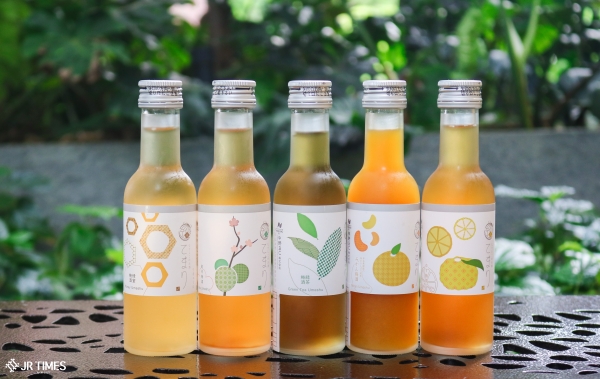Plum-of-a-Kind: What flavour of Temari Umeshu are you? (Personality Quiz)

With its wide range of alcoholic beverages fermented, distilled, or brewed locally and available at hand, there’s just about any and every type of alcohol for drinkers to explore all across Japan. While many would instinctively associate Japan with nihonshu (日本酒) or sake (酒) as well as various brands of beer and whiskey like Suntory, there’s a type of alcohol that is hardly in the limelight despite the many health benefits it reaps… can you make a guess what it is?
The answer is umeshu (梅酒)! Umeshu, or plum wine, is a type of fruit liqueur made from young plums harvested in June, steeped in shochu (焼酎) and sugar. With an alcohol content of between 10–15%, umeshu is generally sweet, sour, and easy to drink, making it a popular drink among the ladies.
What is ume and nanko-ume?
Umeboshi, salted ume made from nanko-ume. (Image credit: photoAC)
To understand umeshu, one must also know about one of its key ingredients: ume (梅 plums). In Japan, ume is one of the most essential ingredients incorporated in Japanese food culture—you may have seen umeboshi (梅干し salted plum) served on top of your rice bowls or in your onigiri (おにぎり rice balls) in Japanese restaurants, as well as in various other food products like jam, tea, and of course, umeshu. Wakayama Prefecture (和歌山県 Wakayama-ken) is known to be the prefecture that produces the highest quality and the most varieties of ume nationwide. And the most popular and premium of them all is the Nanko-ume (南高梅).

Young and unripe Nanko-ume harvested in June. (Image credit: photoAC)
Nanko-ume is characterised by its soft and rich flesh, small seed, thin skin, and larger-than-usual size. Nanko-ume originates from the town of Minabe (南部) in Hidaka District (日高郡 Hidaka-gun) in Wakayama. Surrounded by both the mountains of Kishu and the Pacific Ocean, the town’s location in the prefecture’s central region makes it ideal for the cultivation of Nanko-ume, with mild temperatures all year-round and long daylight hours with terraced hills. While ume has long been harvested in the town, it was through years of dedication and research that the best brand of ume was developed by a local farmer named Takada Sadagusu with the assistance of teachers in the town’s municipal high school—that brand of ume is what we now know as Nanko-ume.
Benefits of Umeshu

Umeshu in the making. (Image credit: photoAC)
Unlike other forms of hard liquor, umeshu has a refreshing drinkability and a fruity aroma that makes it an enjoyable drink to consume in moderation. Tracing back the history of umeshu, we discover that it is linked to health and medicine, just like sake. Traditionally used as a tonic, it is said that the ume’s content of citric acid and other active ingredients in the drink contribute to a number of health benefits such as combating fatigue and heat exhaustion, stimulation of appetite, and improvement of blood circulation.
Umeshu is also known to help relieve stress, having no sulfites, tannins, nor histamines—the usual cause of headaches and migraine amongst alcohol consumers. On top of that, umeshu has less calories as compared to other alcoholic beverages such as beer and wine, and it is also gluten-free. Umeshu also contains essential minerals such as calcium, iron, and magnesium, as well as significant levels of antioxidants that are essential in protecting and energizing your body.
Ways to drink Umeshu

Umeshu rokku. (Image credit: photoAC)
While umeshu can be drunk on its own when served chilled, it can also be enjoyed in a variety of ways as well as in cocktails. Add some ice cubes into your umeshu for “Umeshu on the Rocks” (梅酒ロック umeshu rokku), or add either tonic or soda water with a wedge of lemon for “Umeshu Sour” (梅酒サワー umeshu sawaa). You can also mix your umeshu with green tea, or even drink it warm or hot on a cold winter’s day.
Some famous and traditional brands of umeshu include Choya and Takara Shuzo. However, there are plenty of brands in Japan that sell umeshu in various shapes, sizes, and taste preferences as well. Here, we’d like to share with you Nakano BC’s series of umeshu called “Temari Umeshu” (てまり梅酒).
Nakano BC Temari Umeshu
(Image credit: JR Times / Sue Lynn)
Temari Umeshu is made using nanko-ume, which we know by now is the most premium variety of plum harvested in Wakayama Prefecture. This classic beverage delivers a perfect balance of sourness and sweetness, derived from the fresh aroma of matured umeshu and the accompanying fruit's sweet and tangy flavour. Temari Umeshu’s selection of five refreshing flavours—Original Kishu, Mikan, Yuzu, Green Tea, and Honey—makes it the best entry point for those who are new to umeshu. Who would’ve thought drinking authentic umeshu would be this fun and colourful?
Adorably packaged in a fun size of 180ml, these attractive bottles of umeshu are popular among ladies and are great as gifts or souvenirs. Plus, being small in size, they’re perfect for a casual drinking session at home for you to try out all flavours! Not sure which flavour to try first? Take this personality quiz to find out: What flavour of Temari Umeshu are you?
So which flavour did you get? Regardless of what you got, with its assortment of flavours and the health benefits it reaps, Temari Umeshu is the perfect companion for you to enjoy with your loved ones or friends.
If we’ve managed to convince you, head down to nomono's online shop on Shopee to get your umeshu fix. Temari Umeshu’s full range of flavours is also available for sale at both JW360º’s nomono and JAPAN RAIL CAFE’s retail corner, with a limited-time promotion of 3 bottles for S$36 only (U.P. S$15/each)! To find out more about ume and umeshu, join JAPAN RAIL CAFE’s webinar #StayAtホーム: Fruits Kingdom Wakayama on 16 September (Wed) for a free-for-all introduction to Wakayama’s fruits, as well as a live tasting review on the full selection of flavours of Temari Umeshu. Bon appetit!
This article is written in collaboration with nomono and JW360º.
Header image credit: JR Times





